Spatial Beam Self-Cleaning in Bi-Tapered Multimode Fibers
Abstract
:1. Introduction
2. Experimental Setup
3. Results
4. Discussion
5. Conclusions
Author Contributions
Funding
Institutional Review Board Statement
Informed Consent Statement
Data Availability Statement
Conflicts of Interest
References
- Mollenauer, L.; Grant, A.; Liu, X.; Wei, X.; Xie, C.; Kang, I. Experimental test of dense wavelength-division multiplexing using novel, periodic-group-delay-complemented dispersion compensation and dispersion-managed solitons. Opt. Lett. 2003, 28, 2043–2045. [Google Scholar] [CrossRef]
- Weber, H.G.; Ferber, S.; Kroh, M.; Schmidt-Langhorst, C.; Ludwig, R.; Marembert, V.; Boerner, C.; Futami, F.; Watanabe, S.; Schubert, C. Single channel 1.28 Tbit/s and 2.56 Tbit/s DQPSK transmission. Electron. Lett. 2006, 42, 178–179. [Google Scholar] [CrossRef]
- Liu, X.; Buchali, F.; Tkach, R. Improving the nonlinear tolerance of polarization-division-multiplexed CO-OFDM in long-haul fiber transmission. J. Lightwave Technol. 2009, 27, 3632–3640. [Google Scholar]
- Li, F.; Yu, J.; Fang, Y.; Dong, Z.; Li, X.; Chen, L. Demonstration of DFT-spread 256QAM-OFDM signal transmission with cost-effective directly modulated laser. Opt. Express 2014, 22, 8742–8748. [Google Scholar] [CrossRef]
- Richardson, D.J.; Fini, J.; Nelson, L. Space division multiplexing in optical fibres. Nat. Photonics 2013, 7, 354–362. [Google Scholar] [CrossRef] [Green Version]
- Sakaguchi, J.; Puttnam, B.J.; Klaus, W.; Awaji, Y.; Wada, N.; Kanno, A.; Kawanishi, T.; Imamura, K.; Inaba, H.; Mukasa, K.; et al. 305 Tb/s space division multiplexed transmission using homogeneous 19-core fiber. J. Lightwave Technol. 2013, 31, 554–562. [Google Scholar] [CrossRef]
- Uden, R.G.H.; Correa, R.; Lopez, E.; Huijskens, F.M.; Xia, C.; Li, G.; Schulzgen, A.; Waardt, H.; Koonen, A.M.J.; Okonkwo, C. Ultra-high-density spatial division multiplexing with a few-mode multicore fibre. Nat. Photonics 2014, 8, 865–870. [Google Scholar] [CrossRef] [Green Version]
- Randel, S.; Ryf, R.; Sierra, A.; Winzer, P.; Gnauck, A.; Bolle, C.; Essiambre, R.-J.; Peckham, D.; McCurdy, A.; Lingle, J.R. 6×56-Gb/s mode-division multiplexed transmission over 33-km few-mode fiber enabled by 6 × 6 MIMO equalization. Opt. Express 2011, 19, 16697–16707. [Google Scholar] [CrossRef]
- Watanabe, T.; Kokubun, Y. Ultra-large number of transmission channels in space division multiplexing using few-mode multi-core fiber with optimized air-hole-assisted double-cladding structure. Opt. Express 2014, 22, 8309–8319. [Google Scholar] [CrossRef]
- Choi, Y.; Yoon, C.; Kim, M.; Yang, T.; Fang-Yen, C.; Dasari, R.; Lee, K.; Choi, W. Scanner-free and wide-field endoscopic imaging by using a single multimode optical fiber. Phys. Rev. Lett. 2012, 109, 203901. [Google Scholar] [CrossRef] [PubMed]
- Richardson, D.J.; Nilsson, J.; Clarkson, W.A. High power fiber lasers: Current status and future perspectives. J. Opt. Soc. Am. B 2010, 27, B63–B92. [Google Scholar] [CrossRef]
- Wang, Z.; Wang, D.; Yang, F.; Li, L.; Zhao, C.; Xu, B.; Jin, S.; Cao, S.; Fang, Z. Er-doped mode-locked fiber laser with a hybrid structure of a step-index–graded-index multimode fiber as the saturable absorber. J. Lightwave Technol. 2017, 35, 5280–5285. [Google Scholar] [CrossRef]
- Renninger, W.H.; Wise, F. Optical solitons in graded-index multimode fibres. Nat. Commun. 2013, 4, 1719. [Google Scholar] [CrossRef] [PubMed] [Green Version]
- Wright, L.; Christodoulides, D.; Wise, F. Controllable spatiotemporal nonlinear effects in multimode fibres. Nat. Photonics 2015, 9, 306–310. [Google Scholar] [CrossRef]
- Wright, L.; Renninger, W.; Christodoulides, D.; Wise, F. Spatiotemporal dynamics of multimode optical solitons. Opt. Express 2015, 23, 3492–3506. [Google Scholar] [CrossRef] [PubMed]
- Krupa, K.; Tonello, A.; Barthélémy, A.; Couderc, V.; Shalaby, B.; Bendahmane, A.; Millot, G.; Wabnitz, S. Observation of geometric parametric instability induced by the periodic spatial self-imaging of multimode waves. Phys. Rev. Lett. 2016, 116, 183901–183906. [Google Scholar] [CrossRef] [Green Version]
- Wright, L.G.; Wabnitz, S.; Christodoulides, D.N.; Wise, F.W. Ultrabroadband dispersive radiation by spatiotemporal oscillation of multimode waves. Phys. Rev. Lett. 2015, 115, 223902–223907. [Google Scholar] [CrossRef] [Green Version]
- Eftekhar, A.; Eznaveh, Z.S.; Lopez-Aviles, H.; Benis, S.; Antonio-Lopez, J.; Kolesik, M.; Wise, F.; Amezcua-Correa, R.; Christodoulides, D. Accelerated nonlinear interactions in graded-index multimode fibers. Nat. Commun. 2019, 10, 1638. [Google Scholar] [CrossRef] [Green Version]
- Liu, Z.; Wright, L.; Christodoulides, D.; Wise, F. Kerr self-cleaning of femtosecond-pulsed beams in graded-index multimode fiber. Opt. Lett. 2016, 41, 3675–3678. [Google Scholar] [CrossRef]
- Lopez-Galmiche, G.; Eznaveh, Z.S.; Eftekhar, A.; Lopez, J.; Wright, L.; Wise, F.; Christodoulides, D.; Correa, R. Visible supercontinuum generation in a graded index multimode fiber pumped at 1064 nm. Opt. Lett. 2016, 41, 2553–2556. [Google Scholar] [CrossRef] [PubMed]
- Wright, L.; Liu, Z.; Nolan, D.A.; Li, M.-J.; Christodoulides, D.; Wise, F. Self-organized instability in graded-index multimode fibre. Nat. Photonics 2016, 10, 771–776. [Google Scholar] [CrossRef]
- Ceoldo, D.; Krupa, K.; Tonello, A.; Couderc, V.; Modotto, D.; Minoni, U.; Millot, G.; Wabnitz, S. Second harmonic generation in multimode graded-index fibers: Spatial beam cleaning and multiple harmonic sideband generation. Opt. Lett. 2017, 42, 971–974. [Google Scholar] [CrossRef] [PubMed]
- Guenard, R.; Krupa, K.; Dupiol, R.; Fabert, M.; Bendahmane, A.; Kermene, V.; Desfarges-Berthelemot, A.; Auguste, J.-L.; Tonello, A.; Barthélémy, A.; et al. Nonlinear beam self-cleaning in a coupled cavity composite laser based on multimode fiber. Opt. Express 2017, 25, 22219–22227. [Google Scholar] [CrossRef] [Green Version]
- Guenard, R.; Krupa, K.; Dupiol, R.; Fabert, M.; Bendahmane, A.; Kermene, V.; Desfarges-Berthelemot, A.; Auguste, J.-L.; Tonello, A.; Barthélémy, A.; et al. Kerr self-cleaning of pulsed beam in an Ytterbium doped multimode fiber. Opt. Express 2017, 25, 4783–4792. [Google Scholar] [CrossRef] [Green Version]
- Krupa, K.; Tonello, A.; Shalaby, B.M.; Fabert, M.; Barthélémy, A.; Millot, G.; Wabnitz, S.; Couderc, V. Spatial beam self-cleaning in multimode fibres. Nat. Photonics 2017, 11, 237–241. [Google Scholar] [CrossRef] [Green Version]
- Dupiol, R.; Krupa, K.; Tonello, A.; Fabert, M.; Modotto, D.; Wabnitz, S.; Millot, G.; Couderc, V. Interplay of Kerr and Raman beam cleaning with a multimode microstructure fiber. Opt. Lett. 2018, 43, 587–590. [Google Scholar] [CrossRef] [PubMed]
- Krupa, K.; Tonello, A.; Couderc, V.; Barthélémy, A.; Millot, G.; Modotto, D.; Wabnitz, S. Spatiotemporal light-beam compression from nonlinear mode coupling. Phys. Rev. A 2018, 97, 043836–043842. [Google Scholar] [CrossRef] [Green Version]
- Deliancourt, E.; Fabert, M.; Tonello, A.; Krupa, K.; Desfarges-Berthelemot, A.; Kermene, V.; Millot, G.; Barthélémy, A.; Wabnitz, S.; Couderc, V. Kerr beam self-cleaning on the LP11 mode in graded-index multimode fibers. OSA Contin. 2019, 2, 1089–1096. [Google Scholar] [CrossRef] [Green Version]
- Deliancourt, E.; Fabert, M.; Tonello, A.; Krupa, K.; Desfarges-Berthelemot, A.; Kermene, V.; Millot, G.; Barthélémy, A.; Wabnitz, S.; Couderc, V. Wavefront shaping for optimized many-mode Kerr beam self-cleaning in graded-index multimode fiber. Opt. Express 2019, 27, 17311–17321. [Google Scholar] [CrossRef] [PubMed] [Green Version]
- Fusaro, A.; Garnier, J.; Krupa, K.; Millot, G.; Picozzi, A. Dramatic acceleration of wave condensation mediated by disorder in multimode fibers. Phys. Rev. Lett. 2019, 122, 123902–123909. [Google Scholar] [CrossRef] [PubMed] [Green Version]
- Krupa, K.; Garmendia Castañeda, G.; Tonello, A.; Niang, A.; Kharenko, D.; Fabert, M.; Couderc, V.; Millot, G.; Minoni, U.; Modotto, D.; et al. Nonlinear polarization dynamics of Kerr beam self-cleaning in a graded-index multimode optical fiber. Opt. Lett. 2019, 44, 171–174. [Google Scholar] [CrossRef] [PubMed] [Green Version]
- Niang, A.; Mansuryan, T.; Krupa, K.; Tonello, A.; Fabert, M.; Leproux, P.; Modotto, D.; Egorova, O.; Levchenko, A.; Lipatov, D.; et al. Spatial beam self-cleaning and supercontinuum generation with Yb-doped multimode graded-index fiber taper based on accelerating self-imaging and dissipative landscape. Opt. Express 2019, 227, 4018–24028. [Google Scholar] [CrossRef] [PubMed]
- Podivilov, E.V.; Kharenko, D.; Gonta, V.; Krupa, K.; Sidelnikov, O.; Turitsyn, S.; Fedoruk, M.P.; Babin, S.; Wabnitz, S. Hydrodynamic 2D turbulence and spatial beam condensation in multimode optical fibers. Phys. Rev. Lett. 2019, 122, 103902–103908. [Google Scholar] [CrossRef] [Green Version]
- Niang, A.; Levchenko, A.; Semjonov, S.; Lipatov, D.; Babin, S.; Couderc, V.; Wabnitz, S.; Modotto, D.; Tonello, A.; Mangini, F.; et al. Spatial beam self-cleaning in tapered Yb-doped GRIN multimode fiber with decelerating nonlinearity. IEEE Photonics J. 2020, 12, 1–8. [Google Scholar] [CrossRef]
- Zhang, B.; Ma, S.; He, Q.; Guo, J.; Jiao, Z.; Wang, B. Investigation on saturable absorbers based on nonlinear Kerr beam cleanup effect. Opt. Express 2020, 28, 6367–6377. [Google Scholar] [CrossRef]
- Krupa, K.; Fona, R.; Tonello, A.; Labruyère, A.; Shalaby, B.M.; Wabnitz, S.; Baronio, F.; Aceves, A.B.; Millot, G.; Couderc, V. Spatial beam self-cleaning in second-harmonic generation. Sci. Rep. 2020, 10, 7204. [Google Scholar] [CrossRef]
- Wabnitz, S.; Leventoux, Y.; Parriaux, A.; Sidelnikov, O.; Granger, G.; Lavoute, L.; Jossent, M.; Gaponov, D.A.; Fabert, M.; Tonello, A.; et al. Highly efficient few-mode spatial beam self-cleaning at 1.5μm. Opt. Express 2020, 28, 14333–14344. [Google Scholar]
- Lægsgaard, J. Spatial beam cleanup by pure Kerr processes in multimode fibers. Opt. Lett. 2018, 43, 2700–2703. [Google Scholar] [CrossRef]
- Krupa, K.; Couderc, V.; Tonello, A.; Modotto, D.; Barthélémy, A.; Millot, G.; Wabnitz, S. Refractive index frofile tailoring of multimode optical fibers for the spatial and spectral shaping of parametric sidebands. J. Opt. Soc. Am. B-Opt. Phys. 2019, 36, 1117–1126. [Google Scholar] [CrossRef]
- Chiang, K. Stimulated Raman scattering in a multimode optical fiber: Evolution of modes in Stokes waves. Opt. Lett. 1992, 17, 352–354. [Google Scholar] [CrossRef]
- Gaeta, A.L. Catastrophic collapse of ultrashort pulses. Phys. Rev. Lett. 2000, 84, 3582–3585. [Google Scholar] [CrossRef] [PubMed]
- Tong, L.; Gattass, R.; Ashcom, J.; He, S.; Lou, J.; Shen, M.; Maxwell, I.; Mazur, E. Subwavelength-diameter silica wires for low-loss optical wave guiding. Nature 2004, 426, 816–819. [Google Scholar] [CrossRef] [PubMed]
- Zitelli, M.; Mangini, F.; Ferraro, M.; Niang, A.; Kharenko, D.; Wabnitz, S. High-energy soliton fission dynamics in multimode GRIN fiber. Opt. Express 2020, 28, 20473–20488. [Google Scholar] [CrossRef] [PubMed]
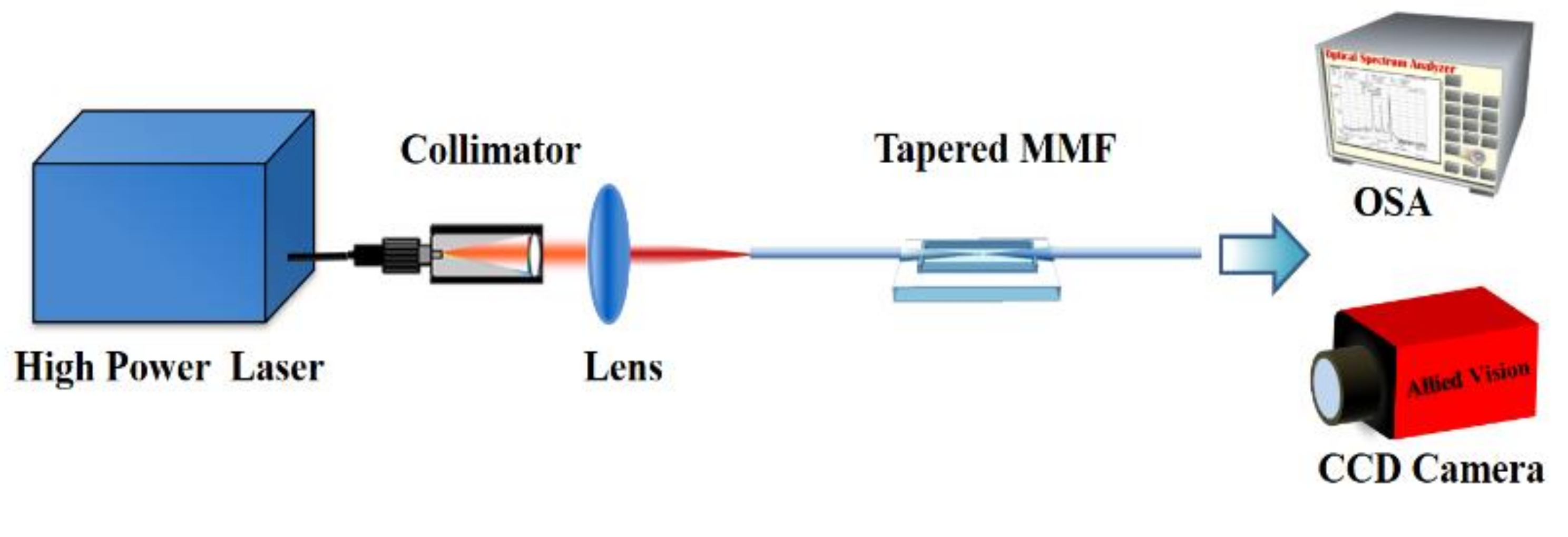
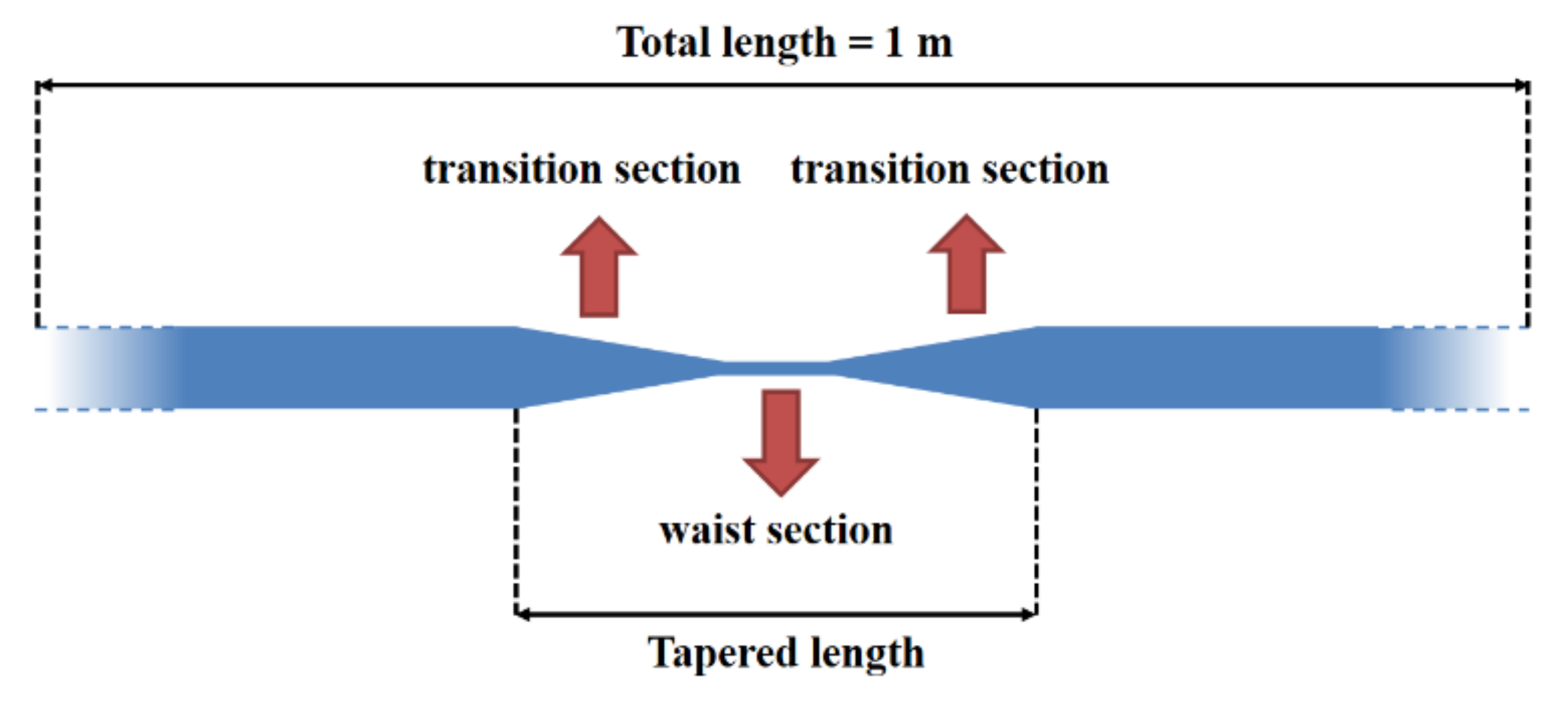
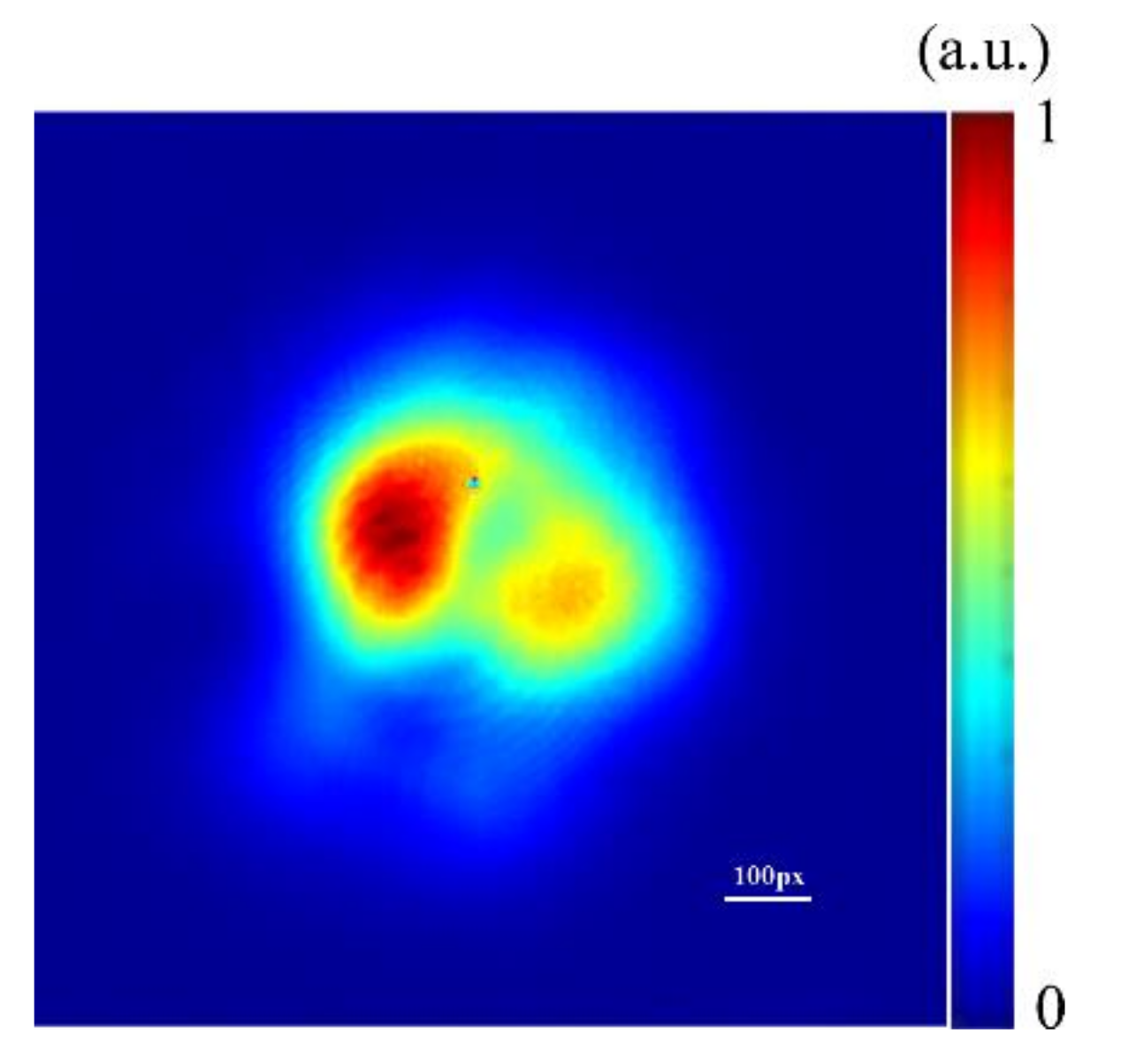

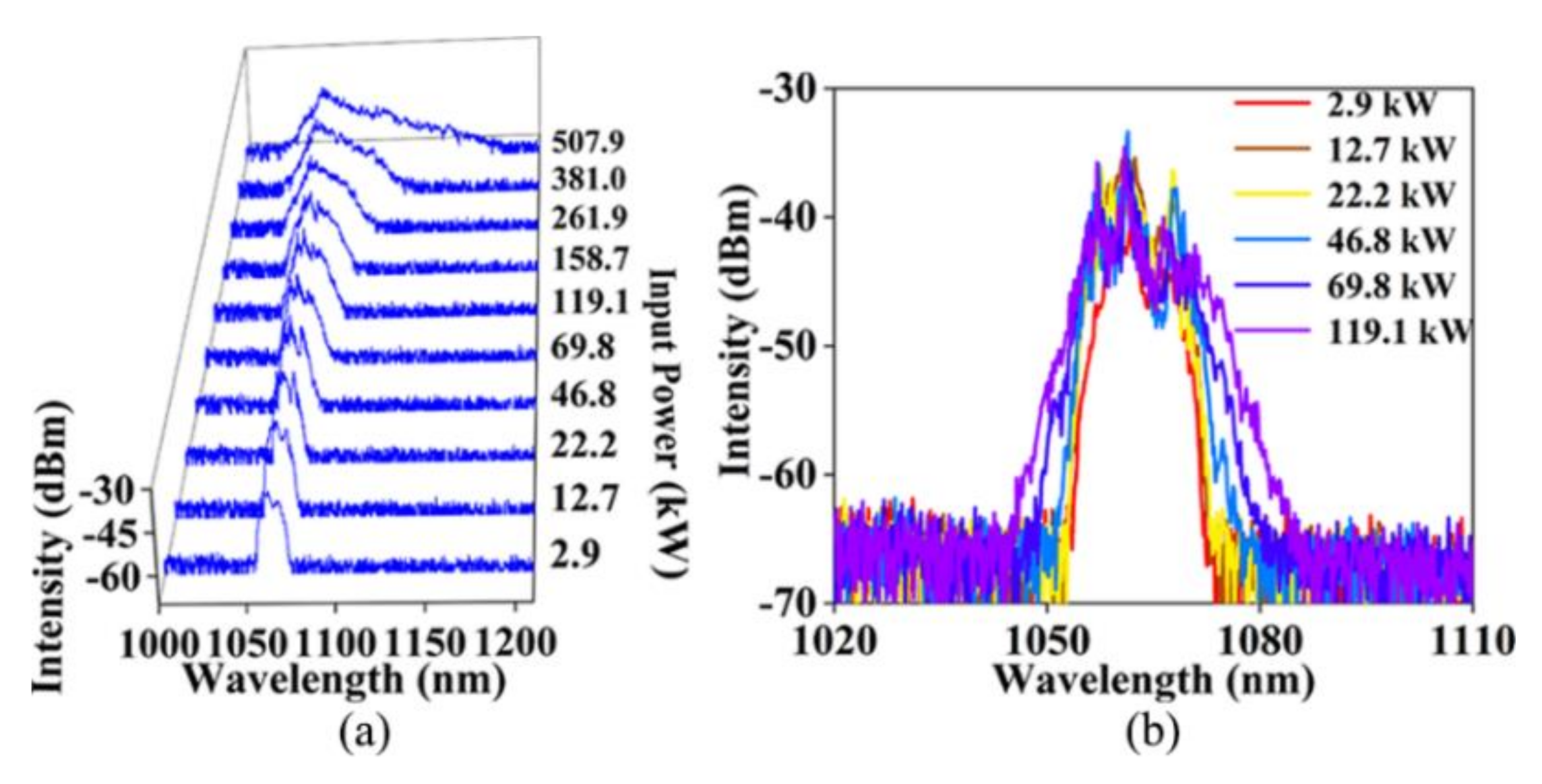



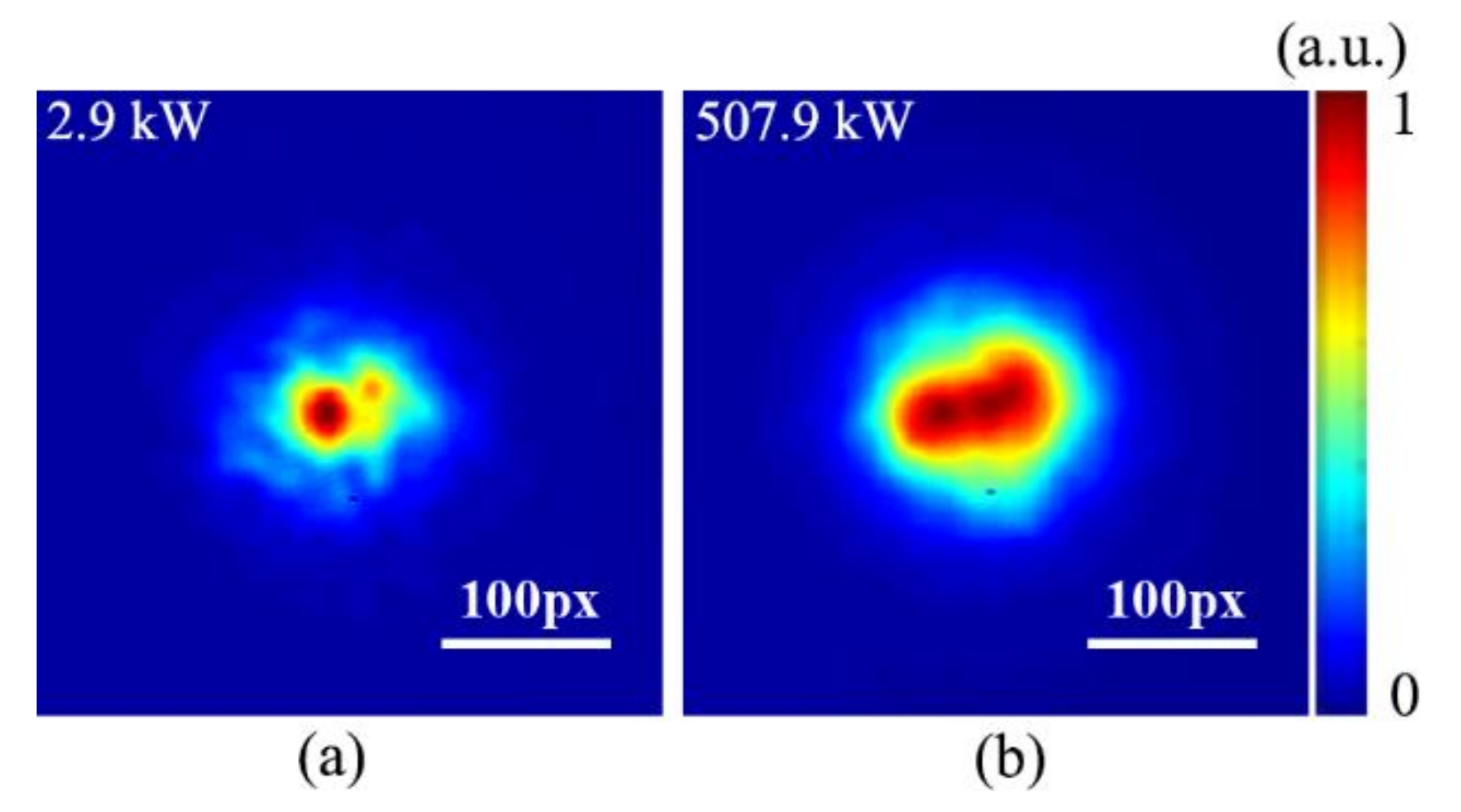
Publisher’s Note: MDPI stays neutral with regard to jurisdictional claims in published maps and institutional affiliations. |
© 2021 by the authors. Licensee MDPI, Basel, Switzerland. This article is an open access article distributed under the terms and conditions of the Creative Commons Attribution (CC BY) license (https://creativecommons.org/licenses/by/4.0/).
Share and Cite
Lin, X.-J.; Gao, Y.-X.; Long, J.-G.; Wu, J.-W.; Li, X.-Y.; Hong, W.-Y.; Cui, H.; Luo, Z.-C.; Xu, W.-C.; Luo, A.-P. Spatial Beam Self-Cleaning in Bi-Tapered Multimode Fibers. Photonics 2021, 8, 479. https://doi.org/10.3390/photonics8110479
Lin X-J, Gao Y-X, Long J-G, Wu J-W, Li X-Y, Hong W-Y, Cui H, Luo Z-C, Xu W-C, Luo A-P. Spatial Beam Self-Cleaning in Bi-Tapered Multimode Fibers. Photonics. 2021; 8(11):479. https://doi.org/10.3390/photonics8110479
Chicago/Turabian StyleLin, Xiao-Jun, Yu-Xin Gao, Jin-Gan Long, Jia-Wen Wu, Xiang-Yue Li, Wei-Yi Hong, Hu Cui, Zhi-Chao Luo, Wen-Cheng Xu, and Ai-Ping Luo. 2021. "Spatial Beam Self-Cleaning in Bi-Tapered Multimode Fibers" Photonics 8, no. 11: 479. https://doi.org/10.3390/photonics8110479
APA StyleLin, X.-J., Gao, Y.-X., Long, J.-G., Wu, J.-W., Li, X.-Y., Hong, W.-Y., Cui, H., Luo, Z.-C., Xu, W.-C., & Luo, A.-P. (2021). Spatial Beam Self-Cleaning in Bi-Tapered Multimode Fibers. Photonics, 8(11), 479. https://doi.org/10.3390/photonics8110479






